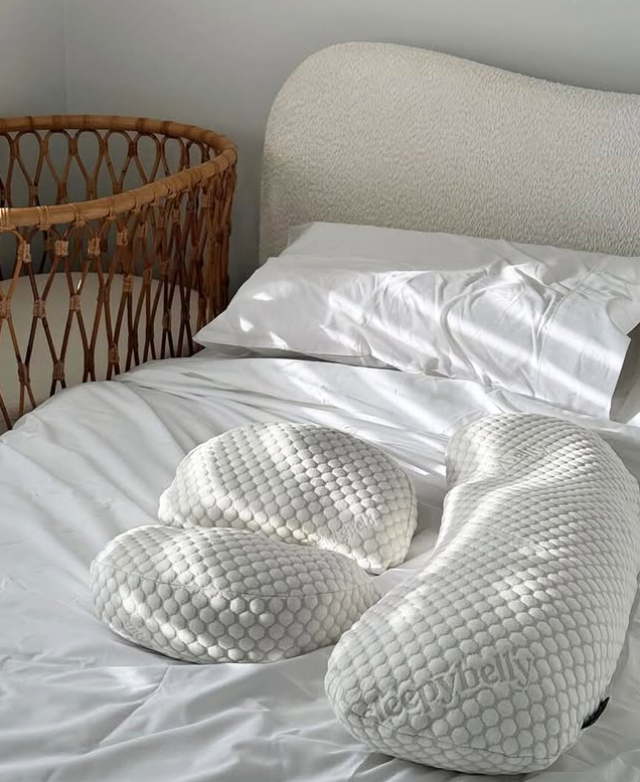Hot nights, shared doona, growing bump. Here’s how to sleep cooler together without a midnight thermostat war.
If you’re pregnant and sharing a bed, “too hot” can feel like your new bedtime default. Hormones turn up your internal thermostat, circulation ramps up, and suddenly your once-cozy doona becomes a heat trap. Add a partner’s body heat and you’ve got a recipe for sweaty, restless sleep.
The good news: you can keep things cool, comfy, and couple-friendly with a few smart tweaks. This guide walks through temperature-regulating sleep habits, breathable bedding swaps, partner-friendly setups, and tech-free tricks that actually work—so you both wake up fresher.

Why pregnancy makes you feel hotter at night
-
Your blood volume increases, your metabolism changes, and progesterone can make you feel warmer overall.
-
Heat builds up around pressure points—hips, bump, and where bodies touch—especially with dense foams or heavy winter bedding.
-
Night sweats are common in pregnancy and the postpartum period.
Cooling is partly about temperature and partly about airflow. Think: light, breathable, moisture-wicking, and easy to adjust at 2 am.
Build a cooler bed, layer by layer
-
Mattress and topper
-
If your mattress traps heat, add a breathable topper. Look for perforated latex or open-cell foam over dense memory foam. Latex sleeps cooler and rebounds faster when you switch sides.
-
Sheets and doona
-
Prioritise natural, breathable weaves. Percale cotton, bamboo and linen feel cooler than sateen. Bamboo/cotton blends are soft, airy, and moisture-wicking.
-
Downsize the doona tog (or GSM) for summer and add a light throw on your partner’s side so they can warm up without cooking you.
-
Consider dual bedding: two lighter single doonas on a queen/king to cut down heat-sharing and tug-of-war.
-
Pyjamas and pillow covers
-
Wear moisture-wicking sleepwear that breathes and stretches with you. Ribbed bamboo/cotton/elastane blends are brilliant in pregnancy.
-
Try Sleepybelly’s 3-Piece Maternity Pyjama Set—soft, breathable, and adjustable, with an elastic tie waistband, gentle on C‑section scars. Another huge plus: the top is short‑sleeved with buttons for easy breastfeeding access. And you get both shorts and pants in the set, so on warmer nights you can switch to the shorts, and on cooler evenings you’ve got the pants ready to go.
-
Use breathable pillow covers. Air-layer bamboo/poly blends help reduce heat build-up around your back and belly.

-
Cooling pregnancy pillow setup
-
Choose a compact, modular pillow that supports you without smothering airflow. The three-piece Sleepybelly Pregnancy Pillow uses activated latex-style fill that feels cooler than dense memory foam and lets air move around your body.
-
Keep a slim wedge under the bump—just enough lift to reduce strain without blocking airflow.
Partner-friendly cooling tricks
-
Side-by-side climate zones: place a quiet fan on your side pointed low across the mattress, not directly at faces. Your partner stays temperate; you get a targeted breeze.
-
Hot-and-cold layering: you take a sheet + light throw; your partner keeps the doona. It’s a simple, no-arguments compromise.
-
Staggered bed prep: cool your side with a breathable ice gel pack on top of the sheet for 10 minutes before bed; remove it when you hop in.
-
Over-pillow cuddle: if you like to spoon, cuddle “around” the back support of your pregnancy pillow—less skin-to-skin heat, more airflow, same closeness.
Night-time routine for cooler sleep
-
Hydrate ahead of time: drink water through the evening, then sip (don’t chug) before bed to balance hydration with fewer bathroom trips.
-
Lukewarm shower: too cold can rebound and make you feel hotter; lukewarm lowers skin temperature gently.
-
Keep it light: a small snack with protein and complex carbs can steady nighttime temperature swings.
-
Ventilate: a cracked window and a cross-breeze help more than blasting cold AC. Keep the bedroom 18–20°C if possible.
The pregnancy pillow configuration that stays cool
Try this simple, airy setup:
-
Wedge under belly: slim lift to take pressure off hips and bump.
-
Long back support: curve it along your lower-to-mid back, leaving space near the shoulders.
-
Knees: a thin cushion between the knees to keep the hips aligned without heavy insulation.
Why it works:
-
Less surface contact = less trapped heat.
-
Air moves across your torso and between your knees and ankles.
-
You maintain side-sleeping alignment, which helps reduce pain and restless tossing.
Explore a breathable, bed-sharing-friendly option: Sleepybelly Pregnancy Pillow.

Common heat traps to avoid
-
Foam “fortresses”: large, single-piece pregnancy pillows can over-insulate. Modular designs let heat escape.
-
Heavy winter bedding in shoulder seasons: adjust GSM earlier than you think.
-
Synthetics against skin: favour bamboo/cotton/linen as your first layer.
-
Late-night spicy dinners or hot drinks: both can dial up warmth and reflux.
Partners: how to help her keep cool (and sleep better)
-
Offer the cool side: if one side catches the evening breeze, swap kindly.
-
Be the airflow engineer: set up the fan angle and check sheets aren’t bunched around her bump.
-
Temperature truce: agree on “sheet for her, doona for you” as the default.
-
Quick reset assist: when the wedge slips, retuck it so she doesn’t have to twist.
What to wear and why it matters
-
Breathable, stretchy, easy-access: ribbed bamboo/cotton/elastane PJs reduce friction and wick moisture.
-
Adjustable waistband: keeps pressure off the belly and pelvis.
-
Nursing-friendly top: if you’re up for night feeds later, button-up tops make life easier (and cooler).
See the cooling, comfy option many mums rate for warm nights: Sleepybelly Maternity Pyjamas.
Safety, sleep position, and staying cool
After the first trimester, side-sleeping is generally recommended. If you wake on your back, don’t stress—just roll to your side again. A supportive pregnancy pillow helps you settle on your side more easily, which can improve comfort and sleep quality. For a friendly, evidence-informed context on sleep in pregnancy, see the resources below.
Quick checklist: cooler sleep for two
-
Sheets: percale cotton, bamboo/cotton, or linen
-
Doona: lighter GSM, or two singles on a shared bed
-
Pyjamas: moisture-wicking bamboo/cotton/elastane
-
Pillow: modular, breathable design; avoid bulky heat traps
-
Fan: low, angled across the mattress, not at faces
-
Water: within easy reach; small sips overnight
-
Window: a crack for cross-ventilation where safe
-
Routine: lukewarm shower, light snack, screen dimmed
The cool-night takeaway
You don’t need to blast the AC or banish your partner to sleep comfortably. With breathable layers, a smart pregnancy pillow configuration, and a few airflow tweaks, you can keep temperature tantrums at bay and drift off more easily—together. Start with lighter bedding, moisture-wicking PJs, and a modular pillow like the Sleepybelly Pregnancy Pillow, and consider pairing it with the airy 3-Piece Maternity Pyjama Set for cooler, calmer nights.



